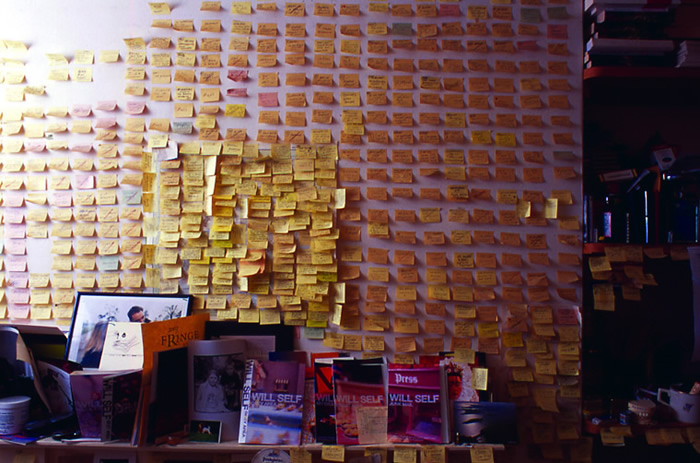Arriving at the Stazione di Santa Maria Novella I feel like a bit of a Rodin’s Messenger of the Gods: after all, I’m in Florence merely to make money, while all around me people are purely intent on having a good time. I walk towards the centre of town; the throng of tourists swirling about the flanks of the basilica church parts for a moment, and beside one of those hat stalls that have sprung up the world over (selling panamas, trilbies and caps of many colours, none of which you ever notice anyone wearing), I see a man with no feet lying on the pavement and begging, the ends of his stumps apparently smeared with mercurochrome, or something else that stains them an obscene reddish-orange.
Turning the corner into the Via Tornabuoni I’m confronted by the plate-glass windows of a number of fancy Italian shoemakers – Gucci, Baldinini, Fendi – and I reflect on how teetering about on these high heels would be as precarious as trying to hobble on … stumps.
If you wish to experience a place light-heartedly, gaily and creatively – let alone spiritually – you need to go there with a good heart; moreover, I believe places are like people and the genius loci is a sort of soul, which means that, as with human encounters, first impressions are lasting ones. My mother was quick with her hands – you wouldn’t see the blow coming, just feel the stinging ringing of its impact. As I stood in the loggia of the Uffizi, my head tintinnabulated with pain. Mother strode back into the gallery to admire Botticelli’s Primavera, I slumped down on a stone bench and lifted my paperback to blot out the hordes – it was, as I recall, The Wooden Horse by Eric Williams, and its setting was perfectly in tune with my own 10-year-old’s predicament; wasn’t I, too, compelled to perform a repetitive action over and over again in order to escape from my guards?
Usually my mother didn’t mind me filling my metaphorical trouser bottoms with earthy words as we vaulted our way through the Renaissance, but in Florence she’d seen vermilion and struck out, ensuring that for me, for ever, the city – and by extension any appreciation of its art – would be associated with violence.
Not for this Pavlovian doggie the sensation reported by Marie-Henri Beyle (aka Stendhal) on contemplating the city’s magnificence: “Life drained from me, I walked with the fear of falling …”, or, rather, I do walk on towards the Ponte Vecchio feeling faint and dizzy, but only because it’s occurred to me for the first time that perhaps my entire antipathy to crowded art galleries had its origins in that 1970 slap. Really, I consider, a lot of Lebensraum could be created in the world’s most popular visitor attractions simply by encouraging parents to slap their sulky children – obviously it’ll take a number of years to feed through, but given enough corporal punishment now, come 2040 the Uffizi could well be empty. I’ve been back to Florence a number of times since Mum pasted me, but the city’s art treasures remain beyond my ken.
Instead, on this visit – as before – I confine myself to the streets. However, while I may be walking in crowded alleys, the singularity of my mercenary purpose renders me curiously invisible: I am like Cosimo I de’Medici, striding along the snaking rooftop corridor Vasari designed for him, so the Grand Duke might walk from the Palazzo Vecchio to the Palazzo Pitti without having to mingle with his subjects. I buy olives and Provolone in a delicatessen and eat them sitting on the weir that bisects the Arno; I look up at the bridges and see they are festooned with the cream of western art-loving girlhood – thousands upon thousands of them, stroking their hair, strumming their guitars and sketching with their iPads. Florence has been providing a safe haven for posh-girls-who-paint since the Victorian era; in the 1880s there were several English-language dailies published in the city, and even if you did manage to secure a room with a view there was every likelihood it would be a key component of someone else’s … view.
My room looks out on the gloomy defile of the Borgo San Jacopo; moreover, I’m not allowed to smoke in it. I go down to the river terrace to make a little sfumato of my own, and as I squint at the Ponte Vecchio through its fine embellishment, a man who’s puffing alongside me retells the old anecdote about how the bridge was spared during the German retreat of 1944 on Hitler’s personal orders. But the creatively destructive Nazis did blow up all the buildings at either end, which is why there is now a curious blend of the medieval and the modernist on show as the cubicular retrobotteghe merge with the much newer blocks. My self-appointed tour guide keeps on: did I know that originally the shops on the bridge were all butchers’, but the Medici replaced them with goldsmiths in the 16th century?
Well, no, I didn’t, but there’s something a bit Messenger of the Gods-ish about the way he’s banging on, so I take myself off to bed. And sleep fitfully: some time in the small hours the carousing of the PGWPs and their boyfriends merges seamlessly with the tap-tapping of leather pieceworkers in the sweatshop immediately opposite my room. I cram the pillow over my head and struggle to recapture the substance of my dream; where was I … ? That’s right: arriving at the Stazione di Santa Maria Novella …
